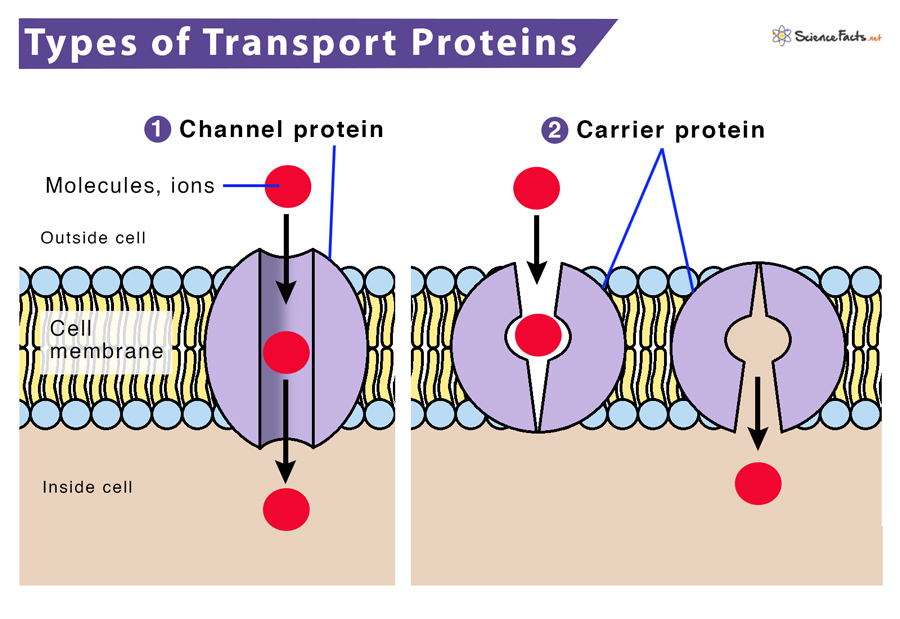Transport Proteins
The movement of substances (ions and molecules) across the cell membrane is called cell transport. The most important feature of the cell membrane is that they are selectively permeable, meaning they allow specific substances to pass through while preventing others. This feature is extremely critical for maintaining a proper internal environment within the cell to keep them alive and remain functional.
The cell membrane is selectively permeable due to its molecular makeup. It allows small, hydrophobic, nonpolar molecules such as carbon dioxide and oxygen to pass easily through their lipid bilayer. In contrast, hydrophilic polar molecules such as water, charged ions such as sodium, potassium, and large molecules such as glucose cannot diffuse simply across them. Such molecules require a carrier protein molecule to assist their transport. They are known as transport proteins.
What are Transport Proteins and What Do they Do
Transport proteins or transporter are integral membrane proteins that help other substances to diffuse in and out of the cell. They are similar to cell receptors in some ways. Both are transmembrane proteins that transport signals from outside the cell to the inside. Transport proteins generally perform two main types of transport in cells:
Facilitated diffusion: It is a form of passive transport. Here, the transport protein creates an opening for the substance to diffuse down its concentration gradient.
Active transport: In this form of transport, the cell uses energy to transport a substance against its concentration gradient.
How do Transport Proteins Work
They follow three necessary steps:
- The substance first attaches to the protein or glycoprotein receptors on the exterior side of the cell membrane.
- They are then passed to specific integral proteins that span the entire cell membrane.
- Modifications in the integral protein structure allow substances to be released from one side of the cell to another.
Types of Transport Proteins
All transport proteins do not play a role in both facilitated diffusion and active transport. Accordingly, they are classified into two main types: 1) channel proteins and 2) carrier proteins.
1) Channel Proteins
They make a hole or a pore in the cell membrane. Channel proteins have hydrophilic domains exposed to intracellular and extracellular environments with an additional hydrophilic inner core that provides an opening through the membrane layers. Transfer of substances through the channel allows polar molecules to avoid the nonpolar middle layer of the cell membrane, otherwise prevented from entry into the cell.
Channel proteins act as a pore in a membrane that remains open all the time. The binding of a particular ion to the channel activates the channel protein to function.
Examples
- Aquaporins allow the diffusion of water.
- Ion channel proteins specific to sodium and chloride ions in kidney tubules.
Now, we discuss a special type of channel protein – gated channel proteins.
Gated Channel Proteins
They are transport proteins that open a gate, allowing a molecule to pass through the membrane. Gated channel proteins have a binding site that is highly specific for a given molecule or ion. The channel protein opens or shuts once they receive a stimulus. Depending on the gated channel, the stimulus may be chemical, electrical, mechanical, or temperature. The opening and closing of these channels change the relative concentration of ions on both sides of the membrane, helping signal transmission.
Some common examples are sodium, potassium, and calcium gated channels in a nerve or muscle cell.
2) Carrier Proteins
They are transport proteins that are found embedded in the cell membrane and remain open at one side of the membrane at any instance. Carrier proteins carry the ions or molecules across the membrane by changing their shape after binding to the substrate. Though not clearly understood, carrier proteins are found to change shape when their hydrogen bonds get affected. This change in structure allows the bound molecule to move from one side of the cell to another.
Carrier proteins are particular for a substance, adding to the overall selectivity of the cell membrane. Carrier proteins are involved in both active and passive transport.
Examples
- The sodium-potassium pump transports sodium and potassium ions across the cell membrane against their concentration gradient.
- Sodium-glucose transporter that cotransport glucose and sodium in the small intestine.
- Glucose transport protein or GLUTs that transport glucose and other hexose sugars.
FAQs
Ans. The proteins of the electron transport chain are located in mitochondria.
Ans. Yes, active transport requires specialized carrier proteins for transport.
Ans. The Golgi apparatus is responsible for transporting proteins within a eukaryotic cell.
Ans. Active transport uses carrier proteins for transporting substances in and out of the cell.
Ans. The Golgi apparatus modifies, sorts, and packages different substances for transporting them out of the cell.
Ans. No, simple diffusion does not require a transport protein.
Ans. Ferritin functions to store and transport iron in the cell.
Ans. Albumin, the most abundant plasma protein, transports fatty acids and some hormones in cells.
Ans. Plasma retinol binding protein (RBP), a type of carrier protein, transports vitamin A in the blood.
-
References
Article was last reviewed on Friday, February 17, 2023




